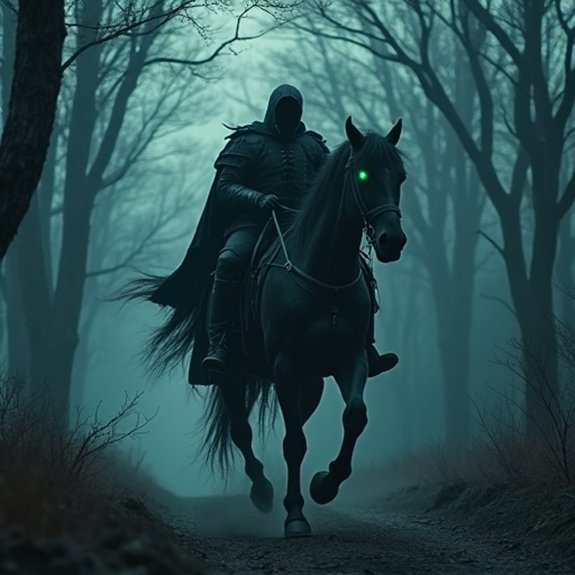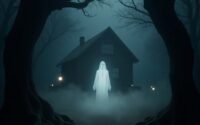The Headless Horseman Type Myths
The headless horseman doesn’t belong to just one culture’s nightmares. From Ireland’s death-herald Dullahan to Germanic phantom huntsmen, these decapitated riders have thundered through folklore for centuries. They’ve appeared on moonless roads, predicted deaths, and embodied humanity’s deepest fears about mortality. But what’s driven so many different societies to create remarkably similar tales of headless specters? The answer reveals something profound about the human psyche itself.
Introduction

When autumn winds whistle through bare branches and shadows grow long, tales of the Headless Horseman gallop through the imagination of cultures worldwide. This spectral rider isn’t merely Washington Irving’s creation from “The Legend of Sleepy Hollow.” He’s emerged independently across continents, haunting Celtic folklore, Germanic legends, and Asian ghost stories for centuries.
The archetype typically features a decapitated warrior who rides at night, searching for his lost head or seeking vengeance against the living. He’ll appear on moonless nights, pursuing travelers along lonely roads. Some versions depict him carrying his head under one arm; others show an empty void above his shoulders. These myths reflect humanity’s primal fears of death, dismemberment, and the restless dead who can’t find peace.
Celtic Dullahan Folklore Traditions
Among the oldest headless horseman legends, Ireland’s Dullahan predates most European versions by centuries. This Celtic spirit rides a black horse while carrying his severed head under one arm. The head’s eyes dart about, and when the Dullahan stops riding, he calls out a person’s name—that individual dies immediately.
Traditional accounts describe the Dullahan’s whip made from a human spine and his wagon decorated with funeral objects. He throws blood on those who dare watch him pass. Gates open at his approach, and no barrier can stop his journey. Celtic communities believed he served as death’s messenger, collecting souls for the afterlife.
The Dullahan couldn’t cross running water or tolerate gold—even a gold pin would send him fleeing. These weaknesses offered mortals rare protection against this harbinger of death.
Notable Cases or Sightings

Historical records document several chilling encounters with headless horsemen across Europe and North America. In 1820, Dutch settlers near Tarrytown, New York, reported seeing a headless figure on horseback near the Old Dutch Church. The rider allegedly chased travelers along the Albany Post Road before vanishing at the bridge.
Ireland’s County Sligo witnessed multiple sightings throughout the 1800s. Witnesses described a dark coach drawn by headless horses, with a headless coachman cracking a whip made of human spine. These encounters typically occurred on moonless nights near crossroads.
Germany’s Odenwald forest generated reports in 1763 of a headless huntsman who’d appear during storms. Local magistrates documented testimonies from farmers who claimed the specter warned them of impending deaths in their villages.
Common Theories or Explanations
While skeptics dismiss headless horseman sightings as mere folklore, researchers have proposed several explanations for these persistent accounts. Psychologists suggest mass hysteria and collective delusion drive communities to report similar supernatural encounters, especially during periods of social upheaval. Historical trauma theory links these legends to actual executions and battlefield decapitations that communities couldn’t psychologically process.
Natural phenomena offer alternative explanations. Swamp gas creates glowing orbs that appear to float at horseback height. Fog banks distort riders’ silhouettes, making heads seem to vanish in darkness. Sleep paralysis episodes explain bedroom visitations by headless figures.
Some historians argue these stories served practical purposes: warning travelers about dangerous roads, enforcing curfews, or concealing smuggling operations. The headless horseman myth persists because it combines primal fears with plausible misidentifications.
Frequently Asked Questions
How Do Headless Horseman Myths Differ Between Eastern and Western Cultures?
Western headless horseman myths typically feature vengeful spirits seeking their lost heads or victims, while Eastern versions often portray them as demons or yokai who’re guardians of specific locations or serve as moral warnings.
What Modern Media Adaptations Have Popularized the Headless Horseman Legend?
Tim Burton’s “Sleepy Hollow” (1999) transformed Washington Irving’s tale into gothic horror. The TV series “Sleepy Hollow” (2013-2017) modernized the legend. Video games like “World of Warcraft” and children’s shows have featured headless horseman characters.
Are There Any Religious or Spiritual Practices to Ward off Headless Horsemen?
Traditional folklore suggests people’ve used iron horseshoes, Christian crosses, and running water as protective barriers against headless horsemen. Some cultures recommend carrying gold coins or reciting prayers while avoiding crossroads at midnight where they’re said to appear.
Do Headless Horseman Stories Appear in Indigenous American Folklore Traditions?
Indigenous American folklore doesn’t traditionally feature headless horseman stories. These tales arrived with European colonization, particularly through Dutch and German settlers. Some tribes later incorporated similar ghostly rider motifs after contact with European storytelling traditions.
What Psychological Archetypes Do Headless Horseman Figures Represent in Mythology?
Headless horseman figures embody death’s inevitability, punishment for transgression, and the uncanny terror of the incomplete human form. They’re manifestations of guilt, divine justice, and humanity’s primal fear of decapitation—the ultimate disconnection between mind and body.


